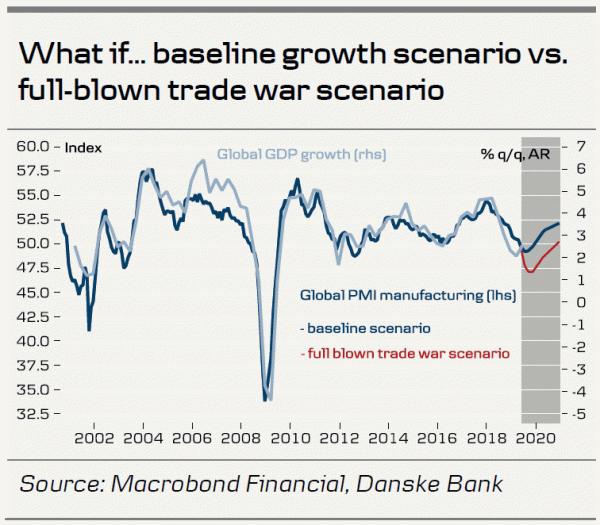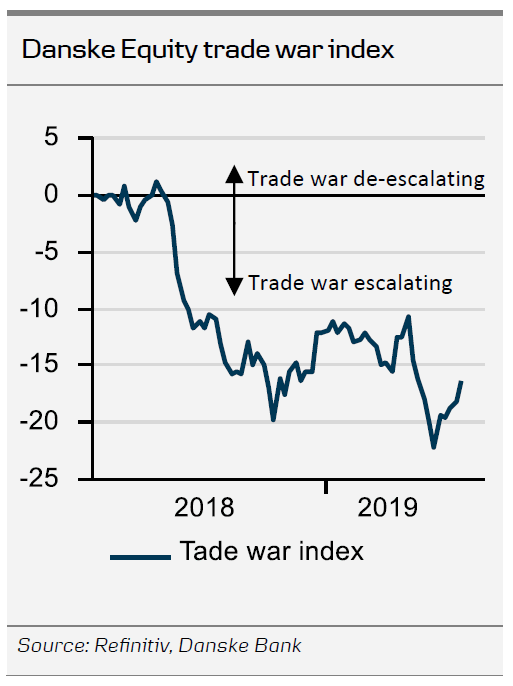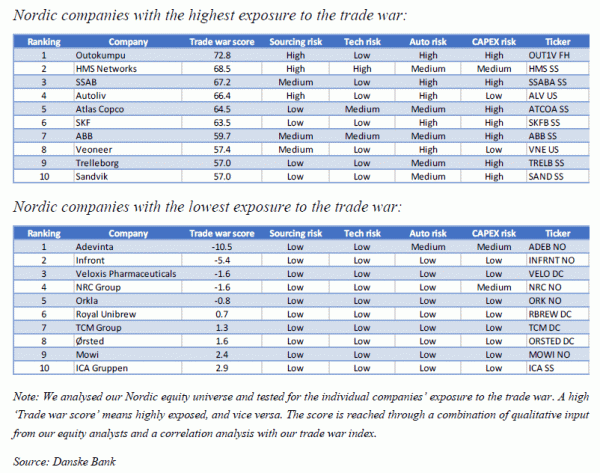- As widely expected, the Xi-Trump meeting ended with a ceasefire in the trade war. The export ban on Huawei was also lifted, at least partially.
- The ceasefire is good news in the sense that it confirms that both sides want to make a trade deal. President Trump’s comments afterwards suggest he sees a trade deal as a key component of his election campaign.
- However, large obstacles remain to reach a deal that satisfies both sides and we still expect a rocky path ahead.
- We continue to look for high volatility in equity markets in the short term and do not see the ceasefire as a game changer for FX markets.
The ceasefire is a reality
As widely expected, the ceasefire became a reality. Here is what we know:
- There will be no new tariffs on China for now.
- The trade talks will restart.
- There is no deadline on a potential tariff increase, as was the case with the previous ceasefire, where tariffs were supposed to go up after three months if there was not enough progress in trade talks.
- Regarding the export ban on Huawei, the news was not very clear, but it seems there will be at least a partial lifting of the export ban. Initially Trump said he had told Xi that the Huawei issue would have to wait until the ‘very end’. However, he also said, “we sell to Huawei a tremendous amount of product that goes into the various things they make and that is ok”. A Chinese diplomat said: “As for Trump’s comments that some restrictions on Huawei will be removed, we will of course welcome this if those words are put into action”. Trump said during the press conference that there would be a meeting on Sunday on Huawei and the Commerce Department list. The interpretation by most media, including the Chinese, was that US companies could now sell to Huawei again.
In his press conference, Trump mentioned farmers as significant beneficiaries of a trade deal with China. Trump also mentioned the strong US economy. It suggests to us that Trump prefers a trade deal with China over no deal as part of his election campaign. It would help him keep the strong economy going and give important gifts to the farmers, who are crucial voters in several swing states.
During the press conference Trump said the US and China could be “strategic partners”. However, this is very much at odds with every official US document made during his administration, which describes China as a revisionist power (most recently in the US ‘Indo-Pacific Strategy’.
Where to go from here: A rocky path to a trade deal
We now expect a new round of high-level trade talks soon either in Washington or Beijing (mostly likely in Beijing, as they were in Washington last time.) We still expect negotiations to be difficult as the two sides seem far from each other on critical points. China has its’ ‘red lines’, which are on points that the US side has seen as paramount for a deal.
Also, for now, Trump is not in a hurry to make a deal. Although the US economy has slowed, it is still quite robust. Stock markets have also remained strong with new highs reached lately.
The Chinese economy is suffering more, but China’s ‘red lines’ are exactly that: areas where it will not move and where there is broad consensus in China that there should be no concessions. Hence, China will not budge when it comes to the US demand to change specific laws and when it comes to the need for a more balanced language and overall trade deal. Xi indicated this at the G20 meeting when he said China must “defend sovereignty, pride and core interests”.
The bottom line is that while a ceasefire has been agreed to, we still expect a rocky path from here towards a trade deal and renewed escalation can still not be ruled out at some point. We do expect a trade deal to be struck during H2, though, as Trump should be able to get a deal he can sell as a big win to the US public. It would also be a deal that can benefit him in his election campaign, where he is likely to partly present himself as the guarantor of a strong economy and the one who delivered a significant improvement for US farmers and business opportunities in China.
What about equities? Good news mostly discounted, and damage already done to the business cycle
Equities are perhaps the most exposed asset class to the trade war. This means the ceasefire is a positive. The fact that markets have gone up since 5 May, even though it marked a re-escalation of the trade war (as Trump aborted the talks and tweeted that he would raise tariffs on USD200bn of Chinese products from 10% to 25%, effective 10 May), does not indicate that trade no longer matters. Rather, it is due to central banks, led by the Fed, signalling an aggressive monetary easing. That (at least in the eyes of the market) neutralised some of the negative effects from the trade conflict.
However, from an equities point of view, the base case of the G20 talks was also the best case, and an outcome that we think was much discounted. Even this ‘best case’ entails plenty of uncertainty, and regardless, we suspect a lot of the damage to the business cycle, the earnings cycle and confidence, is already done. Since the trade war started back in March 2018, production and confidence in manufacturing in particular has deteriorated. Plans for capital expenditure have been shelved. 5 May represents another hit, again clearly visible in most June confidence indicators (even though models and our leading indicators suggest they should have improved). This tells us that corporates are sensitive to trade issues. Many companies are also looking to move production to diversify their supply chain, but with adverse effects on productivity.
This spells risks for earnings – lower growth is a danger to the top line, weak productivity is a danger to margins. In two weeks the global earnings season will kick off. We have low expectations due to the above factors and we fear that analysts are behind the curve, failing to cut estimates enough. On aggregate, the outcome could disappoint for the first time in many years. There is a risk of an earnings recession in 2019. The trade war could also be the perfect excuse (scapegoat) for companies to lower guidance (lower guidance is usually the biggest trigger for a lower share price).
We thus continue to expect high volatility in the short term with a clear risk of equity drawdowns. Renewed escalation in the trade war can still not be ruled out.
However, taking a longer view, we also believe a deal will eventually be struck before year-end and provide impetus for the global economy to recover again in 2020. We therefore expect equities to outperform bonds on a 12-month horizon.
In our Nordic universe we have many companies exposed to the trade war, through several channels. Below is a summary of the most and least affected ones.
Ceasefire no game changer for FX markets
The ceasefire agreement is not a game changer for FX and commodity markets in our view. The USD should stay broadly unchanged. The lower probability of new US tariffs on China is negative for the USD, but a mitigating factor is that the odds the Fed will cut by 50bp in July will likely go down, which would be USD-positive. Commodity prices should stay well supported by the improved outlook for a trade deal. That in turn should benefit commodity currencies, the AUD, NZD, CAD and NOK. Finally, we could see this change in tone in the trade talks weigh a bit on the JPY.















